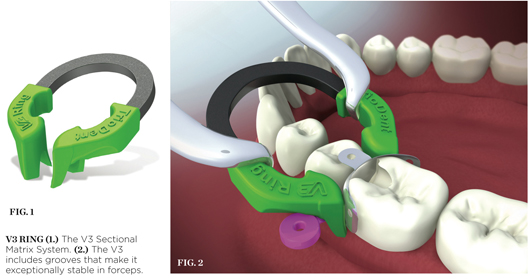V3 Sectional Matrix System
Predictably tight contacts, perfect anatomy, and reliable accuracy were key factors in the design.
The V3 Ring, launched in May 2008, was the next generation ring following the very successful V-Ring. The V-Ring brought to Class II restorations two major innovations: V-shaped tines and a nickel-titanium spring.

The shape of the tines solved a longstanding clinical problem: how to get compatibility between the retainer ring and the wedge in the interproximal space. With the V-shape, the ring easily accommodated the wedge. At the same time, the extra width of the tines meant the ring suddenly had much wider indications for use, making it effective in situations where other rings would collapse into a cavity.
The nickel-titanium (NiTi) spring introduced two important new features to the system: its memory and its remarkable elasticity. NiTi has a “memory,” so with constant flexing it will return to its original position, far more so than stainless steel. This gave the ring the advantage of retaining its shape and, therefore, extending its useful longevity. The NiTi spring also exerted optimal separation force over a wider range of embrasure sizes than rings made from stainless steel. This is because, while stainless steel follows Hooke’s Law of Elasticity (which states that the force created is proportional to the extension of the spring), with NiTi the force curve flattens out the greater the extension.
Triodent researchers have established that the ideal separating force for a retainer ring on the teeth is between 3 kg and 4 kg. In testing, the researchers found that a stainless steel ring similar in design to the new V3 Ring was in this ideal region for only a narrow band; between 6.3 mm and 7.5 mm of extension. The two V3 Rings (Universal for molars and Narrow for premolars) generated 3 kg to 4 kg of force through a combined opening range of 3 mm to 8 mm. So, the clinical significance of the flattening curve is that V3 Rings generate the ideal amount of force over a wide range of embrasure sizes.
The original V-Ring did, however, have some stainless steel, an inner band that incorporated the tines. Wanting to remove stainless steel from the picture entirely, Triodent developed the V3 Ring, a stronger NiTi ring and the first with glass-fiber reinforced plastic tines. The shape of the tines gave the ring even wider indications for use, being designed to match buccal and lingual contours of posterior teeth to prevent the ring from collapsing into preparations with wide proximal boxes, even when a cusp was missing. Great thought went into the V3 Ring shape, making their anatomy and force consistent whether the ring was placed mesially or distally, with an ideal cavity form that saved time spent on finishing.
The V3 Ring was also designed with an 18° angle relative to the occlusal plane, making it easy to stack for MODs and simultaneous multiple restorations. Additionally, its shape includes grooves that make it exceptionally stable in forceps.
A ring does not make a system, however, so in the V3 Matrix and the Wave-Wedge, Triodent completes a trio of system components with a huge array of features.
The V3 Matrix band was designed with anatomy the foremost consideration. It includes a rolled marginal ridge which, when positioned correctly, reduces marginal ridge finishing to a minimum. The S-shaped vertical contour also closely replicates the anatomy of the proximal surface and allows the matrix to slide past the gingival margin rather than buckling on the edge. The band is just 30 µm thick but seems stronger because of the overall 3D shape of the matrix. Greater curvature on the horizontal plane means more of that curvature remains as the matrix wraps around the tooth.
The Wave-Wedge’s wave shape and flexible wings adapt to the interproximal space for a superior seal. The wedge also has a hollow underside that protects the gingival papilla. And that concavity means Wave-Wedges are easily stackable, so they can be inserted effortlessly from both the lingual and buccal side during the same procedure.
Both V3 Matrices and Wave-Wedges have holes designed to fit Triodent’s cross-over Pin-Tweezers, for easy insertion and removal. This makes these tiny components very secure, and highly unlikely they will be dropped at that critical moment. The V3 Matrix also has a tab on the top that acts as a handle. When bent in the Pin-Tweezers, that tab provides a “contra-angle,” making positioning easy.
Triodent recommends that the V3 Sectional Matrix System be used with a rubber dam. The V3 inventor and Trident CEO, Dr. Simon McDonald, places the Wave-Wedge before doing his cavity preparation. In nearly all cases he finds he can then place the V3 Matrix without needing to remove the wedge.
For more information, contact:
Triodent
Phone: 800-811-3949
Web: www.triodent.com
Disclaimer
The preceding material was provided by the manufacturer. The statements and opinions contained therein are solely those of the manufacturer and not of the editors, publisher, or the Editorial Board of Inside Dentistry . The preceding is not a warranty, endorsement, or approval for the aforementioned products or services or their effectiveness, quality, or safety on the part of Inside Dentistry or AEGIS Communications. The publisher disclaims responsibility for any injury to persons or property resulting from any ideas or products referred to in the preceding material.





